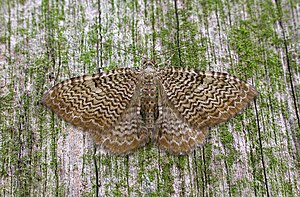Shaft tensioner
| Shaft tensioner | ||||||||||||
|---|---|---|---|---|---|---|---|---|---|---|---|---|

Shaft tensioner ( Hydria undulata ) |
||||||||||||
| Systematics | ||||||||||||
|
||||||||||||
| Scientific name | ||||||||||||
| Hydria undulata | ||||||||||||
| ( Linnaeus , 1758) |
The shaft clamp ( Hydria undulata , Syn. : Rheumaptera undulata ) is a butterfly from the family of the tensioner (Geometridae). The species name is derived from the Latin word undulatus with the meaning "wavy" and refers to the wave pattern on the upper side of the butterfly's forewing.
features
butterfly
The moths reach a wingspan of 24 to 32 millimeters. There is no difference in color between the sexes. The fore wing color varies from light brown to reddish brown on the upper side. Typical of the species and giving it its name is a drawing made up of numerous, closely spaced, strongly wavy dark brown transverse lines. In some specimens, two lines in the disk region merge into a pattern that resembles a row of chain links. A white wavy line on the hem is usually clearly defined. The transverse and wavy line drawing of the forewings continues on the upper side of the hind wing, but is missing in the monochrome, light brown basal region . On the undersides of the wings, the drawing on the front shines through in a weakened form. In addition, there is a black-brown discoid spot on each wing .
Caterpillar
Adult caterpillars are blackish, brownish or greenish in color. They have fine whitish or yellowish back and side back lines, yellow or white side stripes and a light-colored belly surface.
distribution and habitat
The distribution area of the wave tensioner extends from East Asia through the temperate zone to Europe. In East Asia it is represented by the subspecies Hydria undulata sajana . Individual observations were also reported from North America. The main habitat are light swamp and alluvial forests, bushy forest edges as well as gardens and park landscapes. In the Alps , the species rises to heights of 1500 meters.
Way of life
The moths are mostly nocturnal and fly in one generation from May to August. At night they appear on artificial light sources . The caterpillars feed on the leaves of various deciduous trees, for example willows ( Salix ), poplars ( Populus ), alders ( Alnus ), and sometimes bilberries ( Vaccinium myrtyllus ). The caterpillars do not live freely on their food plant, but hide themselves between coiled leaves. On broad-leaved willows, they pull together the edges of the leaf on which they sit. They live from July and pupate in September. The pupa hibernates.
Individual evidence
- ^ Arnold Spuler : The butterflies of Europe , Volume 2, E. Schweizerbart'sche Verlagsbuchhandlung, Stuttgart, 1910, p. 37
- ↑ Distribution worldwide
- ↑ Manfred Koch , Wolfgang Heinicke, Bernd Müller: We determine butterflies. Volume 4: Spanner. 2nd, improved and enlarged edition. Neumann, Leipzig / Radebeul 1976, DNB 780451570 , p. 102/103
- ↑ Walter Forster , Theodor A. Wohlfahrt : The butterflies of Central Europe. Volume 5: Spanner. (Geometridae). Franckh'sche Verlagshandlung, Stuttgart 1981, ISBN 3-440-04951-5 , p. 81/82
- ^ Günter Ebert (Ed.): The butterflies of Baden-Württemberg. 1st edition. Volume 8. Moth VI. Geometridae 1 Ulmer, Stuttgart 2001, ISBN 3-8001-3497-7 , pp. 421-423
literature
- Günter Ebert (Ed.): The butterflies of Baden-Württemberg. 1st edition. Volume 8. Moth VI. Geometridae 1 Ulmer, Stuttgart 2001, ISBN 3-8001-3497-7
Web links
- Lepiforum e. V. - Taxonomy and photos
- pyrgus.de - Butterflies and their ecology
- butterflies - nature butterflies
- ukmoths - Scallop Shell at UKmoths
- britishlepidoptera - Information on the species
- kolumbus.fi - caterpillar
- butterflies and moths - localities in North America
